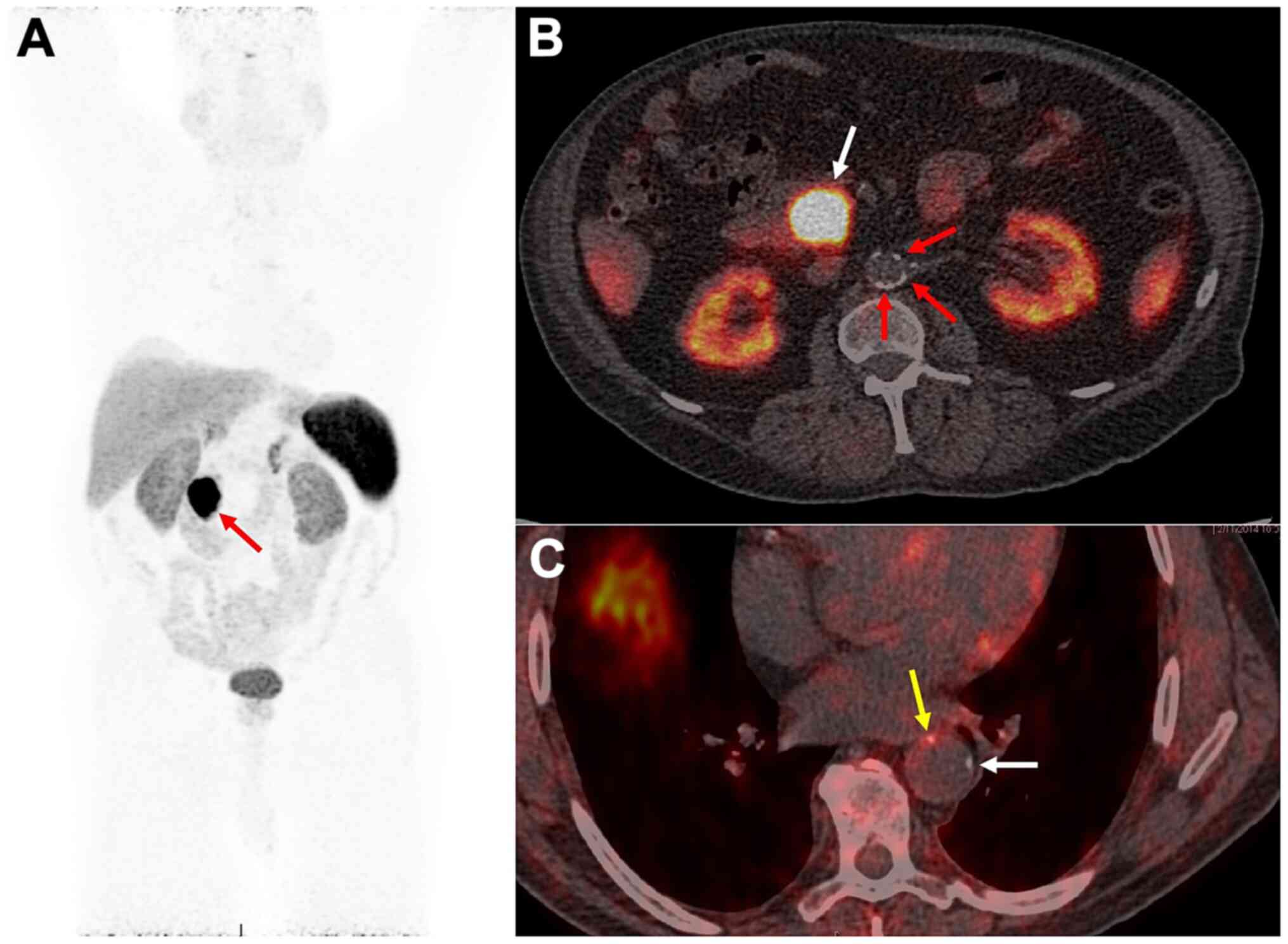|
1
|
Bucerius J, Dijkgraaf I, Mottaghy FM and
Schurgers LJ: Target identification for the diagnosis and
intervention of vulnerable atherosclerotic plaques beyond
18F-fluorodeoxyglucose positron emission tomography imaging:
Promising tracers on the horizon. Eur J Nucl Med Mol Imaging.
46:251–265. 2019.PubMed/NCBI View Article : Google Scholar
|
|
2
|
Krishnan S, Otaki Y, Doris M, Slipczuk L,
Arnson Y, Rubeaux M, Dey D, Slomka P, Berman DS and Tamarappoo B:
Molecular imaging of vulnerable coronary plaque: A pathophysiologic
perspective. J Nucl Med. 58:359–364. 2017.PubMed/NCBI View Article : Google Scholar
|
|
3
|
Dalm VA, van Hagen PM, van Koetsveld PM,
Achilefu S, Houtsmuller AB, Pols DH, van der Lely AJ, Lamberts SW
and Hofland LJ: Expression of somatostatin, cortistatin, and
somatostatin receptors in human monocytes, macrophages, and
dendritic Cells. Am J Physiol Endocrinol Metab. 285:E344–E353.
2003.PubMed/NCBI View Article : Google Scholar
|
|
4
|
Armani C, Catalani E, Balbarini A, Bagnoli
P and Cervia D: Expression, pharmacology, and functional role of
somatostatin receptor subtypes 1 and 2 in human macrophages. J
Leukoc Biol. 81:845–855. 2007.PubMed/NCBI View Article : Google Scholar
|
|
5
|
Hofman MS, Lau WF and Hicks RJ:
Somatostatin receptor imaging with 68Ga DOTATATE PET/CT:
Clinical utility, normal patterns, pearls, and pitfalls in
interpretation. Radiographics. 35:500–516. 2015.PubMed/NCBI View Article : Google Scholar
|
|
6
|
Tirosh A, Papadakis GZ, Millo C, Hammoud
D, Sadowski SM, Herscovitch P, Pacak K, Marx SJ, Yang L, Nockel P,
et al: Prognostic utility of total 68Ga-DOTATATE-avid
tumor volume in patients with neuroendocrine tumors.
Gastroenterology. 154:998–1008.e1. 2018.PubMed/NCBI View Article : Google Scholar
|
|
7
|
Tirosh A, Papadakis GZ, Millo C, Sadowski
SM, Herscovitch P, Pacak K, Marx SJ, Yang L, Nockel P, Shell J, et
al: Association between neuroendocrine tumors biomarkers and
primary tumor site and disease type based on total
68Ga-DOTATATE-Avid tumor volume measurements. Eur J
Endocrinol. 176:575–582. 2017.PubMed/NCBI View Article : Google Scholar
|
|
8
|
Papadakis GZ, Millo C, Sadowski SM, Bagci
U and Patronas NJ: Kidney tumor in a von Hippel-Lindau (VHL)
patient with intensely increased activity on
68Ga-DOTA-TATE PET/CT. Clin Nucl Med. 41:970–971.
2016.PubMed/NCBI View Article : Google Scholar
|
|
9
|
El-Maouche D, Sadowski SM, Papadakis GZ,
Guthrie L, Cottle-Delisle C, Merkel R, Millo C, Chen CC, Kebebew E
and Collins MT: 68Ga-DOTATATE for tumor localization in
tumor-induced osteomalacia. J Clin Endocrinol Metab. 101:3575–3581.
2016.PubMed/NCBI View Article : Google Scholar
|
|
10
|
Papadakis GZ, Millo C, Sadowski SM, Bagci
U and Patronas NJ: Epididymal cystadenomas in von Hippel-Lindau
disease showing increased activity on 68Ga-DOTATATE
PET/CT. Clin Nucl Med. 41:781–782. 2016.PubMed/NCBI View Article : Google Scholar
|
|
11
|
Papadakis GZ, Millo C, Sadowski SM, Bagci
U and Patronas NJ: Endolymphatic sac tumor showing increased
activity on 68Ga-DOTATATE PET/CT. Clin Nucl Med.
41:783–784. 2016.PubMed/NCBI View Article : Google Scholar
|
|
12
|
Papadakis GZ, Bagci U, Sadowski SM,
Patronas NJ and Stratakis CA: Ectopic ACTH and CRH co-secreting
tumor localized by 68Ga-DOTA-TATE PET/CT. Clin Nucl Med.
40:576–578. 2015.PubMed/NCBI View Article : Google Scholar
|
|
13
|
Papadakis GZ, Millo C, Karantanas AH,
Bagci U and Patronas NJ: Avascular necrosis of the hips with
increased activity on 68Ga-DOTATATE PET/CT. Clin Nucl
Med. 42:214–215. 2017.PubMed/NCBI View Article : Google Scholar
|
|
14
|
Papadakis GZ, Millo C, Bagci U, Sadowski
SM and Stratakis CA: Schmorl nodes can cause increased
68Ga-DOTATATE activity on PET/CT, mimicking metastasis
in patients with neuroendocrine malignancy. Clin Nucl Med.
41:249–250. 2016.PubMed/NCBI View Article : Google Scholar
|
|
15
|
Li X, Samnick S, Lapa C, Israel I, Buck
AK, Kreissl MC and Bauer W: 68Ga-DOTATATE PET/CT for the
detection of inflammation of large arteries: Correlation with
18F-FDG, calcium burden and risk factors. xsEJNMMI Res.
2(52)2012.PubMed/NCBI View Article : Google Scholar
|
|
16
|
Pedersen SF, Sandholt BV, Keller SH,
Hansen AE, Clemmensen AE, Sillesen H, Højgaard L, Ripa RS and Kjær
A: 64Cu-DOTATATE PET/MRI for detection of activated
macrophages in carotid atherosclerotic plaques: Studies in patients
undergoing endarterectomy. Arterioscler Thromb Vasc Biol.
35:1696–1703. 2015.PubMed/NCBI View Article : Google Scholar
|
|
17
|
Tarkin JM, Joshi FR, Evans NR, Chowdhury
MM, Figg NL, Shah AV, Starks LT, Martin-Garrido A, Manavaki R, Yu
E, et al: Detection of atherosclerotic inflammation by
68Ga-DOTATATE PET compared to 18F-FDG PET imaging. J Am
Coll Cardiol. 69:1774–1791. 2017.PubMed/NCBI View Article : Google Scholar
|















